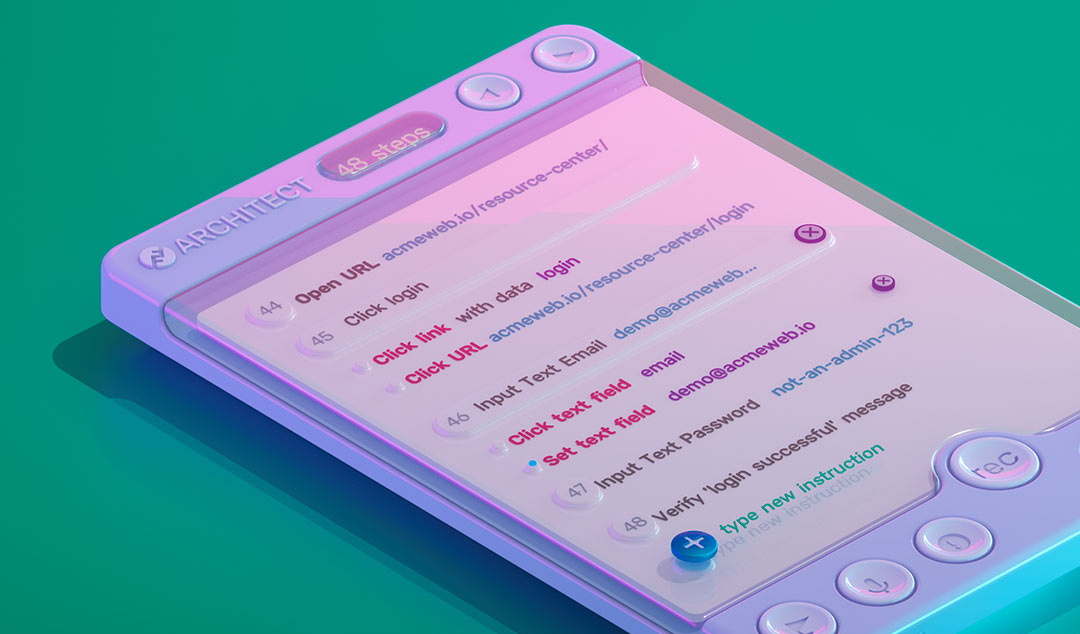Why Test Recorders Often Fail (+ What to Use Instead)
Want to know more about how to combat test recorder failure and what to do instead? Keep reading!

Is your organization losing time and wasting resources while using test recorders? Many companies are without realizing it's happening. Teams know that testing is a critical part of the development process and that automation is key. However, in a time where agile development is the focus and applications change quickly, the traditional test recording and playback method aren't as effective as many people think.
The technology that most organizations use for recording and playback is 20 years old. The truth is that there are many limitations around what teams can record effectively and the way these tests work. Companies are spending a lot of time re-recording tests in an attempt to keep up. This takes a lot of time and often produces a lackluster result.
The truth is that test recorders and playback tools only work in a couple of basic scenarios. Development has evolved, and these tools miss the mark for most teams, creating more problems than they solve. Want to know more about how to combat this and what to use instead? Keep reading to discover why test recorders often fail and the solution for this common problem.
What do test recorders and playback tools do?
The use of these tools is sometimes called “codeless automation”. It allows teams to manually perform actions and save a test. Then, they can re-run these premade tests with one-click, which is a form of light automation. While they do serve a purpose, most teams find that these tools don’t fit their needs. Instead, the tests tend to fail quickly and the effort that teams put into creating the tests can quickly become a waste.
Are test recorders good for anything?
Before we jump into why test recorders often fail, we'll briefly touch on what they are used for, and in what cases they may make sense. After all, there are reasons why this option is still around.
In general, if you are just starting with test automation, it might be worth taking a look at. That said, test recorders are slow, create very large files and break over time. They typically hinder more than they help. However, they can be useful for education or for use in simple, short tests. While test recorders and playback solutions do have a time and place, they don’t work well with most development projects today.
Why do companies use test recorders?
Many companies start here, planning to train their QA team to develop test cases. Using a tool that allows for recording and playback can often seem like a good option in this case. Some see this as a good way to expose QA teams that are used to manual testing to test automation. Teams can use these tools to manually show user-actions for a scripted test case. The result? By doing this, testers create a script that can execute those same actions again.
In a perfect world - this sounds like a great idea. However, there are usually issues that arise when organizations choose to use this method. Many companies realize their mistake when they operate with these test recording tools as a single source of truth. Relying on recorders this way is a huge issue, and dealing with the drawbacks after the fact can create more headaches and cost a lot of money.
Why test recorders often fail
Now that we've covered why test recorders are being used by some organizations, let's talk about why they don't work. Here's a quick look at some of the top reasons why test recorders often fail.
Code changes quickly
When code changes frequently, the tests created with recorders break. Put simply, this makes using the record and playback method a waste of time. More often than not, dealing with broken tests takes more time than doing them manually in the first place. At best, this means that the test automation scripts you do end up with only work short-term. Unless you are running very basic tests, the time and money you put into using a test recorder isn’t likely to pay off.
Duplication
These tests also impact your network resources. Test recorders and playback tools usually duplicate images, code, and objects every time a test is run. That makes it even harder to sort through the code when scripts fail. All the extra data that gets collected can make it more challenging to understand what's actually going on with the code.
When this duplication generates a lot of extra code, it also makes it harder to debug failing scripts. In other words, the tool records more than the steps you take. It’s difficult to understand what part of the code belongs to the test steps and what is the extra data the tool collects. This is a huge problem because while this tool is collecting data that your team believes will be useful, it can quickly turn into a huge mess that takes hours to untangle.
Limited test coverage + gaps
First, test recorders only cover the steps that testers follow. Often times, that's only on the user side and revolves around navigation. The fact is that companies have a lot more to test than just the user side of things, but test recorders limit what you can do. In addition, since it can be so difficult to understand what the tool is doing and how to keep it up and running, sometimes testers can miss critical things.
Missing features
Most test recorders on the market don't offer the features that organizations need to be successful with testing and playback. That isn't to say that there aren't any options out there, but they are few and far between. If you decide to go with a feature-rich option, it's going to come with a premium price tag.
The tests are fragile
This is arguably one of the biggest drawbacks that come with test recorders and playback tools. Even in an ideal scenario where teams understand why a test result happens and what the tool does, these tests are fragile. When changes happen, as they often do, tests break. Even worse, companies usually put up with this and continue to use a recorder much longer than they should because of the high price.
As you can see, there are a number of reasons why test recorders and playback tools fail. The bottom line here is that this old technology hasn’t evolved to meet the needs of organizations today. So, the question becomes: what should organizations choose instead?
Test recorders and playback tools in 2019 — is there a solution?
Yes. While some organizations are still using technology that is decades old, this is not the only path. The good news is that we aren't facing the same limits of the past. AI makes it possible to build solutions to overcome the learning curve that comes with scripting automated tests. While the older technology may still make sense for some cases, most enterprises need an updated solution that has evolved in an era of ever-changing software.
These new technologies make it possible for companies like Functionize to offer solutions that help developers create reliable tests without relying on outdated tools. Investing in these solutions is a great way to keep your team productive and make sure that your team is accomplishing everything they can throughout the development process, without the stress of breaking tests. True automation is the key to success here.
The Functionize solution
Functionize is filling a gap by using the latest technology to fix broken tests. By using natural language processing and machine learning, Functionize’s Adaptive Language Processing engine allows users to create tests by simply writing them in plain English. Our ML engine greatly reduces test maintenance by updating and debugging tests as your application changes. Using this technology, no QA engineer will need to spend endless hours manually debugging tests. Maintenance is triaged by three revolutionary approaches: root cause analysis of test failures, auto-healing of tests based on the AI-modeling of your application, and finally, a recommendation system that analyzes & identifies anomalies to provide one-click updates. These elements work in combination to provide the most advanced level of automated debugging available anywhere.
Wrapping Up
This article covered what test recorders do, why test recorders often fail and what solution your organization can use instead. We hope that this post has given you insight to make the best choice for your organization. We know automated test tools play a very important role. They allow testers to perform the critical task of checking functionality and usability of software. While all tools may have their time and place, solutions that embrace current technology will generally provide the best results. If you’re looking to make the jump into AI test automation, we can help. Want more information and practical tips from Functionize? Click here to head to our blog and discover more content.











